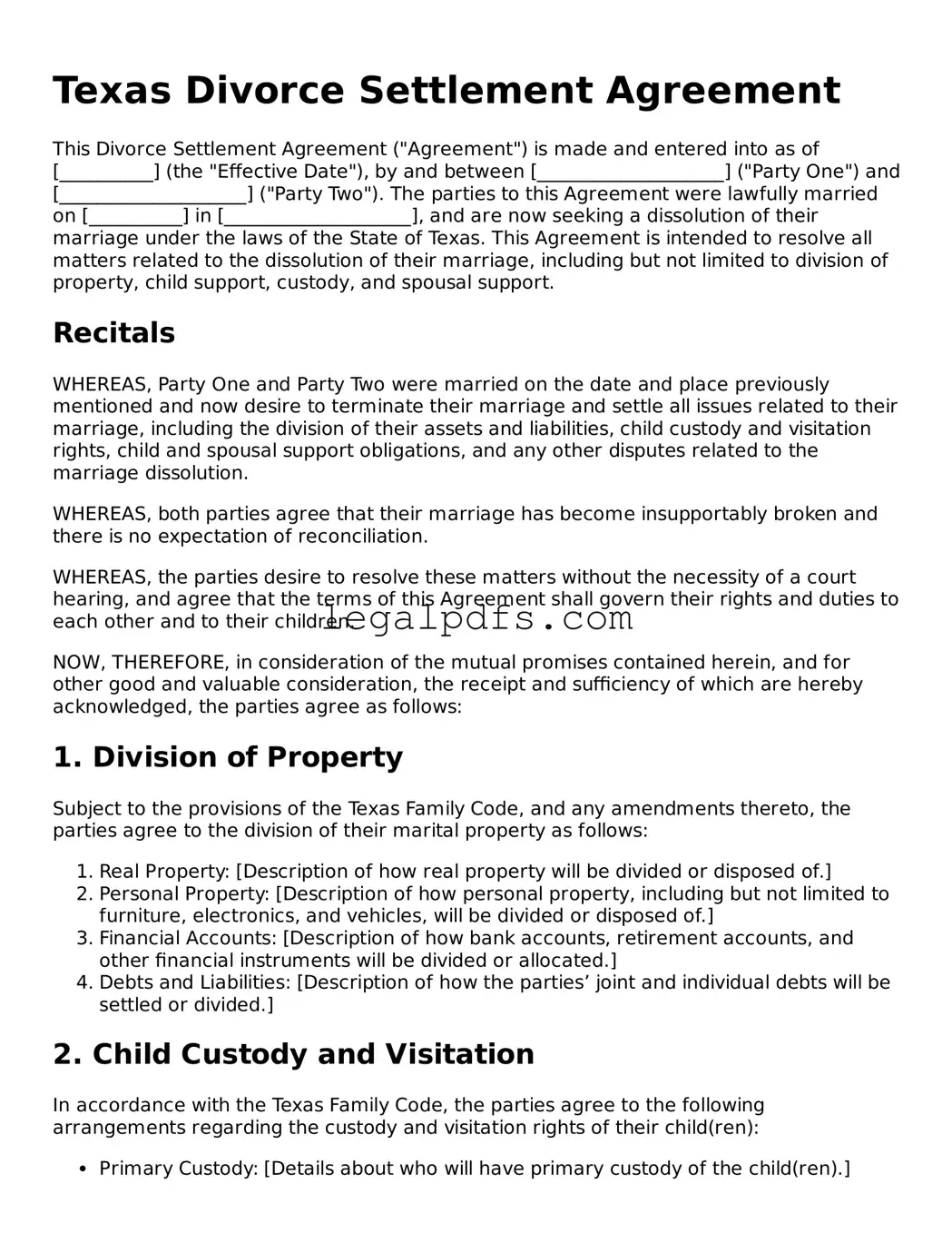Texas Divorce Settlement Agreement
This Divorce Settlement Agreement ("Agreement") is made and entered into as of [__________] (the "Effective Date"), by and between [____________________] ("Party One") and [____________________] ("Party Two"). The parties to this Agreement were lawfully married on [__________] in [____________________], and are now seeking a dissolution of their marriage under the laws of the State of Texas. This Agreement is intended to resolve all matters related to the dissolution of their marriage, including but not limited to division of property, child support, custody, and spousal support.
Recitals
WHEREAS, Party One and Party Two were married on the date and place previously mentioned and now desire to terminate their marriage and settle all issues related to their marriage, including the division of their assets and liabilities, child custody and visitation rights, child and spousal support obligations, and any other disputes related to the marriage dissolution.
WHEREAS, both parties agree that their marriage has become insupportably broken and there is no expectation of reconciliation.
WHEREAS, the parties desire to resolve these matters without the necessity of a court hearing, and agree that the terms of this Agreement shall govern their rights and duties to each other and to their children.
NOW, THEREFORE, in consideration of the mutual promises contained herein, and for other good and valuable consideration, the receipt and sufficiency of which are hereby acknowledged, the parties agree as follows:
1. Division of Property
Subject to the provisions of the Texas Family Code, and any amendments thereto, the parties agree to the division of their marital property as follows:
- Real Property: [Description of how real property will be divided or disposed of.]
- Personal Property: [Description of how personal property, including but not limited to furniture, electronics, and vehicles, will be divided or disposed of.]
- Financial Accounts: [Description of how bank accounts, retirement accounts, and other financial instruments will be divided or allocated.]
- Debts and Liabilities: [Description of how the parties’ joint and individual debts will be settled or divided.]
2. Child Custody and Visitation
In accordance with the Texas Family Code, the parties agree to the following arrangements regarding the custody and visitation rights of their child(ren):
- Primary Custody: [Details about who will have primary custody of the child(ren).]
- Visitation Rights: [Details about the visitation schedule for the non-custodial parent, including holidays, birthdays, and other significant dates.]
- Decision Making: [Details about how decisions regarding the child(ren)’s education, health, and welfare will be made.]
3. Child Support
In accordance with the guidelines of the Texas Family Code, Party One/Party Two shall pay child support to the other party in the amount of $[__________] per month, beginning [__________] and continuing until the child(ren) reach the age of 18 or graduate from high school, whichever occurs later, subject to the conditions outlined in the Texas Family Code.
4. Spousal Support
Following the guidelines of the Texas Family Code, [Party One/Party Two] shall provide spousal support to [Party One/Party Two] in the amount of $[__________] per month, for a term of [__________] months/years, beginning [__________].
5. Amendments and Governing Law
This Agreement may be amended only by a written document signed by both parties. This Agreement shall be governed by the laws of the State of Texas, without regard to its conflict of laws provisions.
6. Entire Agreement
This Agreement contains the entire agreement between the parties relating to the subject matter hereof and supersedes all prior agreements and understandings, oral or written, between the parties with respect to such subject matter.
IN WITNESS WHEREOF, the parties hereto have executed this Agreement as of the first date written above.
Signature: _________________________
Print Name: [Party One’s Name]
Date: [__________]
Signature: _________________________
Print Name: [Party Two’s Name]
Date: [__________]
